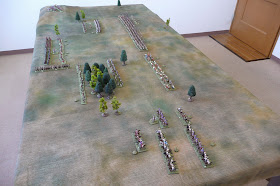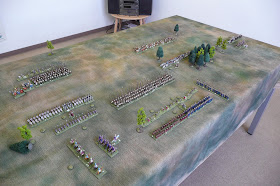The situation is that Alexander II of Epirus, Pyrrhus's son, has joined forces with the denizens of Magna Graecia to take advantage of a Rome weakened by a just-concluded Punic War. If successful, this brave endeavour will establish once and for all the independence of the Greek city states of Southern Italy.
Alexander has brought over 15,000 phalangites, 15,000 mercenaries and 4000 horse to combine with the Tarentines.
In Lost Battles terms, his army looks like this:
- 25,000 phalangites organised into six average (Macedonian) and two levy (Tarentine) units.
- 7,500 Thracians and Illyrians, or three average heavy infantry units.
- 5,000 peltasts, or two heavy infantry units.
- 2,500 slingers, or one light infantry unit.
- 4000 Greek cavalry, organised as two guard veteran and two average units. Alexander and his general, Nearchus, each have a veteran unit under their personal command.
- 2000 Tarantine cavalry, organised as one veteran and one average unit.
The total fighting value of this force is 70.
The Romans in response send a somewhat thrown-together force comprised of 4 legions plus alae, and an additional legion and ala picked up en-route.
- 30,000 heavy infantry organised into twelve legionary units.
- 12,000 light infantry in two levy units.
- 4,000 cavalry organised as one veteran and three average units.
With the addition of the consul Gauis Genucius Clepsina as an average commander, the total fighting value of this force is 71.
Alexander has a gentle hill on which to deploy, while the Romans have a wood in their right centre and a steep hill on their left flank.
Turn 1 (deployment turn).
The Romans deploy with the infantry in the middle three zones, pushing forward the velites in the centre and through the wood. The cavalry is divided into a weak left and a strong right.
Alexander deploys his phalangites on the hill with the peltasts and thureophoroi in support. Nearchus leads the bulk of the cavalry against the Roman right while Alexander himself goes to the right with a view to taking the heights on the Roman left and turning the flank.
 |
| Romans on left and Greeks on the right. |
Turn 2.
The Romans push forward all along the line and dress the cavalry for contact.
 |
| Roman advance. |
 |
| Greek cavalry advances. |
The Romans attack all along the line. They drive off the slingers (1 hit), disorder the Tarantines (1 hit) and sow confusion amongst the peltasts holding the left of the Greek line (2 hits). On the right an unnamed tribune leads an effective charge against Nearchus who pays for his caution by seeing his Tarentine light horse and the mixed Greek cavalry unable to withstand the Roman attack (2 hits). Only tiredness prevents the Romans from following up their advantage further (they just miss scoring another hit due to the negative modifier for charging from a distance).
 |
| Roman success in the charge. |
 |
| The cavalry battle it out. |
 |
| The peltasts are met with missiles from the woods. |
 |
| The phalanx must be driven off this hill! |
Nearchus and Alexander lead the Greek ripostes as the cavalry fights continue to build in intensity. The uphill assault is treacherous, but the equites holding the hill have been shaken (1 hit). On the other end of the line Nearchus's second line of horse cut into the Roman line and fight them to a standstill (2 hits).
In the centre the phalanx is proving to be an intimating opponent as the velites and the hastati wrestle its moral and physical weight (2 hits in the centre). On the left of the infantry line the experienced Thracians hold the line against the advancing Romans and the velites fall back under a volley of spears (1 hit).
 |
| The cavalry fight continues. |
Turn 4.
The cavalry on the hill hits back at the Tarentines with Alexander, driving them back down the slope (1 hit). The legionaries of the left make a concerted effort against the far end of the Greek line, and as they work their way into the gaps opened up by their pila and the uneven ground the troops supporting the Macedonians begin to give way (2 hits).
Elsewhere the combats have devolved into exchanges as the troops conserve their energy, but not so in the cavalry attack, where the Romans drive in again on Nearchus and his men. They hold, but barely (1 hit).
 |
| Lines engaged. |
Alexander now commits himself and his guard to the attack and they carry the hill, breaking through on the right (1 hit - a shatter).
 |
| Breakthrough on the right! |
Nearchus urges his Macedonian guard cavalrymen to remember their fame in war, and they return to the combat with renewed vigour. This time all but the veteran Italian cavalry break in the face of the Greek spears (3 hits - 2 shatters).
Everywhere now the battle favours Alexander. What can Clepsina do to turn the tide?
 |
| The Romans are falling apart under the pressure. |
Turn 5.
The veteran cavalry on the right fall upon the flank of one overly-enthusiastic unit of pursuers, shattering them and driving them from the field (1 hit - 1 shatter), but there are three more units to deal with and the odds against the Italians are long.
Clepsina decides to pull back his demoralised centre and force the phalanx to come down off its hill to continue the fight. He cannot retreat them all, so the rest of his men hold in place to cover the withdrawal.
 |
| Clepsina pulls back |
Nearchus and his men now overcome the last of the Italian cavalry and rush on to outflank the Roman right.
 |
| Nearchus attacks. |
Alexander comes around behind the Roman left and threatens Clepsina's centre. The central phalanx follows up the retreating Romans while the rest of the line attacks. The Macedonians left on the hill now turn the tables on their Roman tormenters with a furious attack that leaves the legionaries confused, disorganised and demoralised (2 hits, 1 of them an all-out-attack, all units in the zone are now spent).
The thureophoroi press similarly hard and the Romans are only just holding on (1 hit).
 |
| The Roman line fragmented and under pressure. |
The consul organises his men to face the enemy as best he can. The triarii from the right join him to stiffen the resistance. Elsewhere the pockets of Roman troops flail against the enemy with no success.
 |
| Clepsina tries to reorganise the line. |
Alexander leads the attack against the milling infantry and Clepsina rides to meet him. After a brief and bloody clash Clepsina falls (1 hit, Clepsina dies in a rally attempt - 1 shatter, 4 rout) and the end is nigh for the Romans.
 |
| Alexander leads the charge and the last Roman resistance begins to crumble. |
Elsewhere the Macedonians attack down the hill (1 hit, all out attack) and this is enough to cause panic and the Roman flight now becomes general.
 |
| Last rites. |
 |
| Roman remnants. |
 |
| The day is lost! |
Alexander has won an astounding victory, and all Italy will tremble at the news!
VPs.
Rome: 1 shattered (6vps), 8 average spent (24vps), 1 veteran spent (4vps), 2 levy spent (4vps).
Epirus: 5 average shattered (30), 1 veteran shattered (8), 1 average commander killed (12), 7 average routed (28), 3 average withdrawn (9), 2 levy routed (6) + 3 points on handicap.
38 vs 96 is a great victory for Alexander.
This was a thoroughly enjoyable game and it was interesting to see Rome really struggle against the phalanx. The lack of command points to spend on combat bonuses and the ability of the phalangites to use their depth to advantage (+1) saw a very one-sided combat in the centre, and that is what ensured that Rome would lose.
Interesting and very entertaining batrep, thanks for posting.
ReplyDeleteCheers, Ross
Ouch! Nothing pyrrhic about that result...
ReplyDeleteVery good report and nice photos. I especially like the 'hit' markers.
ReplyDeleteSplendid looking table and great report!
ReplyDeleteYay! Death to the Romans! Erm.
ReplyDeleteVery good batrep. Thanks for sharing.
The Phalanx in the center with secure flanks and your ability to roll 10-12 on a consistent basis sealed the fate of Rome! ;) Nice looking game Aaron!
ReplyDeleteAlexander's cavalry on the flank with a successful thrust up the center sealed the fate of Rome. Enjoyable BatRep and the troops look fantastic!
ReplyDeleteI agree with others here, an excellent battle report/review good looking table with great painted miniatures. Thanks for sharing
ReplyDeletecheers,
Thanks all, much appreciated! It was good fun doing a what-if scenario generated by someone else. Could be an avenue worth pursuing!
ReplyDeleteCheers,
Aaron
Apologies, Aaron, for missing this post sooner. Wonderful scenario and impressive figures. Best, Dean
ReplyDeleteI wish that this battle was true.
ReplyDelete